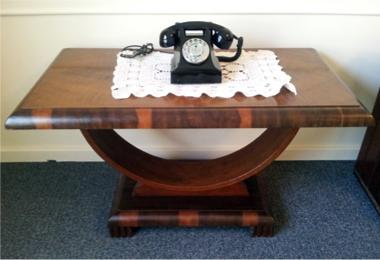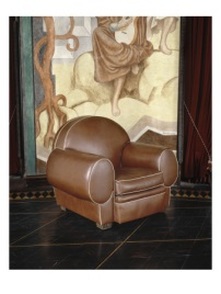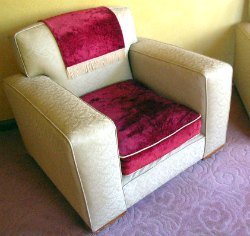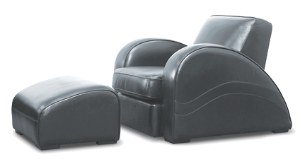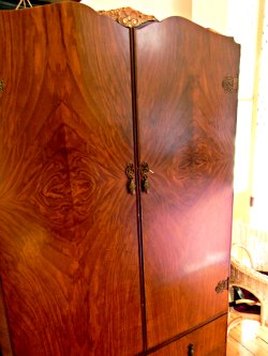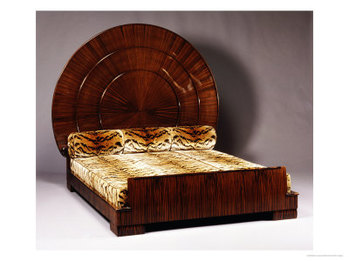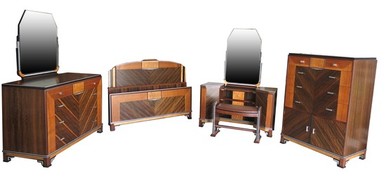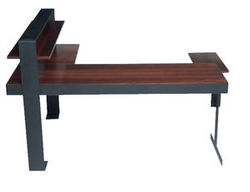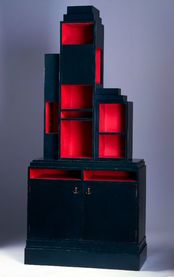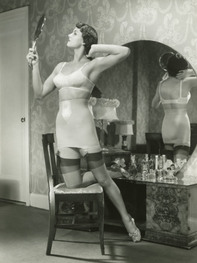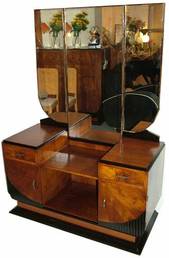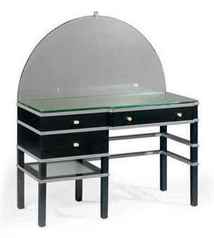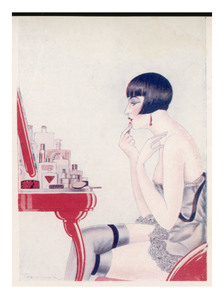
ART DECO
DESIGN BY Megan&Chelsea
DESIGN BY Megan&Chelsea
Art Deco Coffee Tables
U-Shaped Coffee Table ; Designed By :
Coffee wasn't a big thing until the 1950s in : Australia, UK & The USA
when italian immigrants started the coffee culture, to be quite honest, there weren't many coffee tables around because in the 1920s & 1930s the rich upper class people would be more likely to have a cocktail bar in the corner and everyone else was drinking tea from a big pot on the dining room / kitchen table.
Although there does exsist some very high end art deco coffee tables made by designers such as : Paul Frankl of "skyscraper furniture fame" or Donald Deskey.
These tables tend to be extremely modern for example black chrome or lacquered variety which could be expensive.. The woods used were usually Mahogany & Walnut, more exotic woods were used for finer pieces also.
However these "U-Shaped tables" tend to be a little higher than your average low coffee table considering these tables were made for keeping the "bakelite telephone " on or even a stylish ornament would be used .
Also popular were large ashtray stands or even lamps which incorporated a little table, these two would sit beside the club chair and be your ideal spot for "a cup of coffee."
There are alot of Art Deco end tables, which would be placed at the end of the club sofa or by the wall, also there are alot of Art Deco occasional tables for hallways or by a window, these were often veneered in exotic woods.
Coffee wasn't a big thing until the 1950s in : Australia, UK & The USA
when italian immigrants started the coffee culture, to be quite honest, there weren't many coffee tables around because in the 1920s & 1930s the rich upper class people would be more likely to have a cocktail bar in the corner and everyone else was drinking tea from a big pot on the dining room / kitchen table.
Although there does exsist some very high end art deco coffee tables made by designers such as : Paul Frankl of "skyscraper furniture fame" or Donald Deskey.
These tables tend to be extremely modern for example black chrome or lacquered variety which could be expensive.. The woods used were usually Mahogany & Walnut, more exotic woods were used for finer pieces also.
However these "U-Shaped tables" tend to be a little higher than your average low coffee table considering these tables were made for keeping the "bakelite telephone " on or even a stylish ornament would be used .
Also popular were large ashtray stands or even lamps which incorporated a little table, these two would sit beside the club chair and be your ideal spot for "a cup of coffee."
There are alot of Art Deco end tables, which would be placed at the end of the club sofa or by the wall, also there are alot of Art Deco occasional tables for hallways or by a window, these were often veneered in exotic woods.
Art Deco Armchairs
The Famous Elephant ArmChair : Designed by : Jacques Emile Ruhlmann.
Art Deco armchairs are unmistakeable, they tend to have a "cartoon element" to them, with their two tone colors and curvy lines, but at the same time they manage to capture the masculinity of a smoke filled gentlemens' club, the sophistication of a London or even NewYork apartment or even the glamour of a luxury 5 star hotel lobby.
Art Deco armchairs are unmistakeable, they tend to have a "cartoon element" to them, with their two tone colors and curvy lines, but at the same time they manage to capture the masculinity of a smoke filled gentlemens' club, the sophistication of a London or even NewYork apartment or even the glamour of a luxury 5 star hotel lobby.
The ArtDeco ArmChair : From : Everglades House In Leura.
This Art Deco armchair is very traditional looking and typical of the 1920s, it have two main colors (grey&red) and is very square, from the 1930s and onwards, lines became more curved in the response to the trend of streamlining everything. Now the arm chair below starts to show more of a modern influence in one color only which gives it more of a modernist feel and the ottoman or footrest was a necessity part of the form and shape of the pair.
Art Deco Sofa
The design of an Art deco sofa varies greatly from the club lounge style to the tubular steel or chrome frame (rounded steel/Chrome frame)
Tubular steel furniture was influenced by the "Bauhaus Designers" such as Walter Gropius & Marcel Breuer and made by many Art Deco furniture designers, including Eileen Gray. Pail Frankl, Wolfgang Hoddman, Donald Desket & others. Lots of the tubular furniture was made in the 1930s which wasn't attributed to any sort of designer but it was mass produced and solf through department stores.
Many designs have endured and are still reproduced to this day, Chrome and steel framed furniture was usually covered with leather (often black,red or white) also sometimes with exotic animals skins... Materials were Chrome, glass, shiny fabrics, mirrors&mirror tiles.Theatrical contrasts were also widespread, mixing highly polished wood & black lacquer with satin & exotic animal furs.
Tubular steel furniture was influenced by the "Bauhaus Designers" such as Walter Gropius & Marcel Breuer and made by many Art Deco furniture designers, including Eileen Gray. Pail Frankl, Wolfgang Hoddman, Donald Desket & others. Lots of the tubular furniture was made in the 1930s which wasn't attributed to any sort of designer but it was mass produced and solf through department stores.
Many designs have endured and are still reproduced to this day, Chrome and steel framed furniture was usually covered with leather (often black,red or white) also sometimes with exotic animals skins... Materials were Chrome, glass, shiny fabrics, mirrors&mirror tiles.Theatrical contrasts were also widespread, mixing highly polished wood & black lacquer with satin & exotic animal furs.
Art Deco Bedroom Furniture
Art deco bedroom furniture is still easily accessible , especially wardobes & dressing tables, which unfortionately seem to not fit in many houses these days, the wardrobe above is part of a set of two, a smaller one with drawers for the man of the house and a huge one with plenty of hanging space for the lady ..of course ;), they're a part of a set with a dressing table and bed headboard which was made in the 1920s or 1930s in the north side of England. This set isn't the most strongest style of Art Deco but there are still some traces that came from the Art Nouveau, with the ornate decor around the door handles & the decorative pieces at the top. They're good quality, Walnut veneer(which was very popular as an art deco finish) & they have a lovely curvacious form. The decor at the top of the wardrobes are some sort of plastic material which was used from the 1930s to replace more expensive ivory, the curved tops and shape of the mirrors are for keeping up with the new fashion for streamlining.
Art Deco Office Furniture
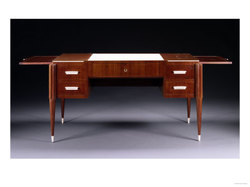
Art Deco office furniture was made in the 1920s-30s but has never really gone out of style which is why designs from the period have continued on till this day. it describes quite a wide range of styles which were developed during the "roaring twenties" and streamlining "mad thirties." there are two main types of art deco which has an effect on the design of office furniture from the period..
"High-End Art Deco" & "Modernist Streamlined Art Deco"
whats the difference you may ask yourself?
in the following paragraphs i will differenciate the two :
"High-End Art Deco" & "Modernist Streamlined Art Deco"
whats the difference you may ask yourself?
in the following paragraphs i will differenciate the two :
Art Deco Dressing Tables (Also known as a vanity) : **ladiess >:)**
Dressing table shapes became more geometric and asymmetrical (in other words lacking symmetry.) They might have a stepped form or a huge round mirror, fan shaped mirrors became common as well as geometric patterned etched onto the glass/Mirror.
Red dessing tables were highly desirable, these days, mirrored dressing tables are being made based on art deco ideas which are totally over the top and blingy and glamourous... in the image above, you'll see a 1920s flapper (In other words a young woman in the 1920s particularly who behaved and dressed in a bold unconventional manner)with the new bobbed hairstyle applies her makeup in the mirror.
The skyscraper design for dressing tables often involved low drawers with two or three levels ( Such as the photo provided above with the black lacquer&chrome)with a tall rectangular or even at times it would be a semi circular mirror. Materials would often be gorgeously textured veneers such as maple or sycamore with perhaps a black enamelled trim.
Black ebony veneer would be trimmed with brass or ivory (replaced by bakelite later on in the 1930s) to create contrast and emphasisE the linear form.
Red dessing tables were highly desirable, these days, mirrored dressing tables are being made based on art deco ideas which are totally over the top and blingy and glamourous... in the image above, you'll see a 1920s flapper (In other words a young woman in the 1920s particularly who behaved and dressed in a bold unconventional manner)with the new bobbed hairstyle applies her makeup in the mirror.
The skyscraper design for dressing tables often involved low drawers with two or three levels ( Such as the photo provided above with the black lacquer&chrome)with a tall rectangular or even at times it would be a semi circular mirror. Materials would often be gorgeously textured veneers such as maple or sycamore with perhaps a black enamelled trim.
Black ebony veneer would be trimmed with brass or ivory (replaced by bakelite later on in the 1930s) to create contrast and emphasisE the linear form.
ART DECO'HISTORY
Some collectable Paris designers in the “artiste decorateurs” tradition include:
Pierre Chareau – an architect and furniture designer with his own store – Maison de Verre
Pierre Legrain – made furniture with a strong African influence
Armand Albert Rateau – influenced by the Egyptian and the exotic and often used Bronze.
Jean Michel-Frank - loved pale woods, sharkskin, vellum and soft leather.
Eileen Gray - a reclusive Irish lady who established in Paris. Her lacquered wood furniture and tubular pieces were sold in her own Galerie Jean Desert from 1922 – 1930.
In Britain the few designers who worked in the high end Art Deco style included:
Gordon Russell - his work blended the early Arts and Crafts movement with Art Deco influences from Paris.
Betty Joel - her feminine Hollywood inspired pieces attracted elite clients from the British Royal family and classy hotels such as the Savoy.
All info was learnt off of;
http://www.decolish.com/ArtDecoFurniture.html#axzz3sRcdVE9K
Pierre Chareau – an architect and furniture designer with his own store – Maison de Verre
Pierre Legrain – made furniture with a strong African influence
Armand Albert Rateau – influenced by the Egyptian and the exotic and often used Bronze.
Jean Michel-Frank - loved pale woods, sharkskin, vellum and soft leather.
Eileen Gray - a reclusive Irish lady who established in Paris. Her lacquered wood furniture and tubular pieces were sold in her own Galerie Jean Desert from 1922 – 1930.
In Britain the few designers who worked in the high end Art Deco style included:
Gordon Russell - his work blended the early Arts and Crafts movement with Art Deco influences from Paris.
Betty Joel - her feminine Hollywood inspired pieces attracted elite clients from the British Royal family and classy hotels such as the Savoy.
All info was learnt off of;
http://www.decolish.com/ArtDecoFurniture.html#axzz3sRcdVE9K
